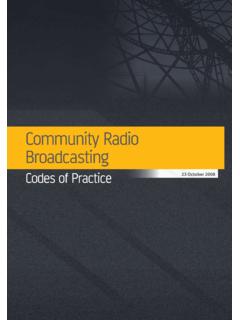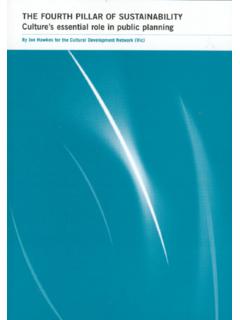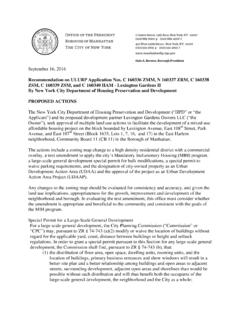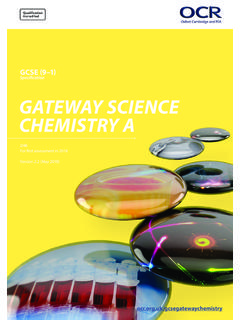Transcription of What is Participatory Learning and Action (PLA): An ...
1 What is Participatory Learning and Action (PLA): An Introduction Sarah Thomas What Is It? Participatory Learning and Action (PLA) is an approach for Learning about and engaging with communities. It combines an ever-growing toolkit of Participatory and visual methods with natural interviewing techniques and is intended to facilitate a process of collective analysis and Learning . The approach can be used in identifying needs, planning, monitoring or evaluating projects and programmes. Whilst a powerful consultation tool, it offers the opportunity to go beyond mere consultation and promote the active participation of communities in the issues and interventions that shape their lives. The approach has been used, traditionally, with rural communities in the developing world. There it has been found extremely effective in tapping into the unique perspectives of the rural poor, helping to unlock their ideas not only on the nature and causes of the issues that affect them, but also on realistic solutions.
2 It enables local people to share their perceptions and identify, prioritise and appraise issues from their knowledge of local conditions. More traditional, extractive research tends to consult' communities and then take away the findings for analysis, with no assurance that they will be acted on. In contrast, PLA tools combine the sharing of insights with analysis and, as such, provide a catalyst for the community themselves to act on what is uncovered. In the UK, PLA approaches are increasingly used in a range of community-based poverty and regeneration projects whenever the active participation of the community is prioritised. By utilising visual methods and analytical tools, PLA enables all community members to participate, regardless of their age, ethnicity or literacy capabilities. Examples of PA Tools How is it Conducted? The repertoire of PLA tools is large and ever-growing and practitioners of the approach are constantly adapting and adding to the toolkit to meet their needs.
3 What follows therefore are merely descriptions and examples of some of the more commonly used tools intended to give a flavour of the approach. Maps Mapping activities are often used as introductory activities. They allow the community to show and talk about how they see the area where they live, the resources/facilities available and what is important to them in their environment. They enable outsiders' to begin to see a community through the eyes of the local people. Time Lines Time lines are a type of diagram that help to record changes in a community/household/life of a community member over time. They are a way of noting the important historical markers and milestones of a community or individual, giving a wider historical context to issues being discussed. They can also enable participants to draw out trends. Transect Walks Transect Walks are a type of mapping activity, but they involve actually walking across an area with a community member/group of community members, observing, asking questions and listening as you go.
4 This information is then represented visually in a transect sketch/diagram. Problem Trees A Problem Tree' or issue tree' is a type of diagram which enables community members to analyse the causes and effects of a particular problem, and how they relate to one another. Constructed around a focal problem/issue, the causes of that problem are traced down below, and the effects above. Escalation of problems Perpetuation of problems Wasted/Underused resources Disillusionment Impact on later Wrong solutions involvement as adults Lost opportunity Wrong problems identified Good ideas not recognised Children's voices are not often heard in the policy and programme design process Resistance Lack of access Views not valued Lack of engagement skills Sub-groups: age/development different needs Individuals previous Legal restrictions Lack of respect Org/individual Experience shortcomings Ethical considerations Communication blocks Power imbalance Ranking Activities Ranking/scoring activities provide a way for community members to weigh up/rate/ prioritise items or issues either relative to one another or according to criteria.
5 Venn / Chapati Diagrams These are two similar types of diagrams that can be used to explore the roles and relationships of individuals, groups and individuals and the links between them. These are just some of the tools that are used as part of the PLA approach. The approach itself is dynamic and flexible but is underpinned by some key principles: Roles are reversed such that local people are seen as the experts'. Handing over the pen' the community members themselves do the drawing, mapping, modelling, diagramming; the facilitators build rapport, listen, question and learn. A Select Bibliography The literature on PLA has grown considerably over recent years. Below are some key texts and internet resources should you wish to find out more. Blackburn, J & Holland, J (1997) Who Changes? Institutionalising Participation in Development London: Intermediate Technology Publications Burkey, S (1993) People First: A guide to self-reliant Participatory development London: Zed Books Chambers, R (1983) Rural development: Putting the last first Harlow: Longman Chambers, R (1997) Whose Reality Counts?
6 London: ITP. CIDT (2001) Participation, Learning and Action (Course handbook) Walsall: University of Wolverhampton CIDT (2001) Participation, Learning and Action . Initial report of a Strategy to Promote Greater Participation in Salford Walsall: University of Wolverhampton (for Salford West Primary Care Group). Gant, K (1991) Dreaming for Real Walsall Community Arts Team Gubbels, P & Koss, C (2000) From the Roots Up: Strengthening Organizational Capacity through Guided Self-Assessment Oklahoma: World Neighbours Guijt, I Questions of Difference: PRA, Gender and Environment (Training Video). Guijt, I & Meera (1998) The Myth of Community:Gender and Participation London: ITP. IIED (1998) Participation, literacy and empowerment PLA Notes 32 London: International Institute for Environment and Development IIED (1998) Participatory Processes in the North PLA Notes 38 London: International Institute for Environment and Development Kumar, S (2002) Methods for Community Participation: A complete guide for practitioners London: ITDG Publishing Neighbourhood Initiatives Enterprises (1999) Planning for real: A Users Guide Nelson, N & Wright,S (1995) Power and Participatory Development: Theory and Practice London: ITP.
7 Pretty, J et al (1995) Participatory Learning and Action : A Trainer's Guide London: IIED. Selener (1999) Participatory Rural Appraisal and Planning Workbook International Institute for Rural Reconstruction Sellers, T (1998) A Participatory Appraisal of Domestic Violence. Community Perceptions in the Caldmore and Palfrey Areas of Walsall University of Hull/Walsall Domestic Violence Forum Slocum, R et al (1998) Power, Process and Participation Tools for Change London: ITP. Wates, N (2000) The Community Planning Handbook London: Earthscan Useful Websites Neighbourhood Initiatives Intermediate Technology Publications Institute of Development Studies One World International Institute for Environment and Development For further information on PLA contact: University of Wolverhampton, Centre for International Development and Training Patricia Daniel








